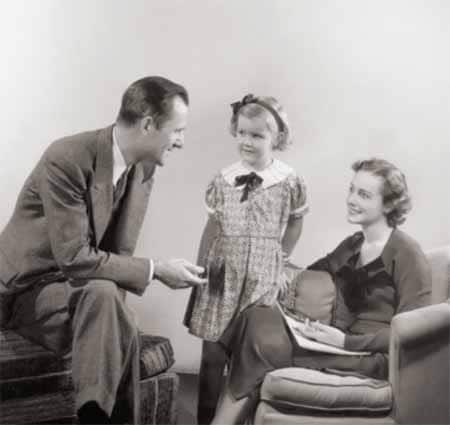
Getting married and having kids are some of the biggest events in our lives. And yet we largely slide into these significant turning points. Sure, there is a big event accompanying them – the wedding, the birth – but what’s surprising is how quickly the novel and disruptive becomes the ordinary and everyday. Even though you form a new family unit, you usually don’t have to give it much thought beyond keeping it generally functioning from day to day.
For this reason, you may never have contemplated the question of why. Why get married? Why have a family? The importance of each individual having a clear purpose is often stressed these days, but few of us will travel this life alone. We’ll make our way through the world as part of a family. Thus it is not enough to know your own purpose — who you are and where you are going. You must also determine the purpose of your family unit. Why does it exist, what does it stand for, and where are you going, together?
If you’ve never taken the time to answer these questions, or even contemplated them, it’s time to draft a family mission statement.
What Is a Family Mission Statement?
“A family mission statement is a combined, unified expression from all family members of what your family is all about — what it is you really want to do and be — and the principles you choose to govern your family life.” -Stephen Covey
A mission statement is just what it sounds like – a description of an individual’s, company’s, or, a family’s, raison d’être – its reason for existing. A family mission statement encapsulates your idea of the good life and lays out your family’s purpose, goals, and standards. All members of the family have a hand in articulating these values and all agree to live them.
Companies often use mission statements to direct their decisions and operating procedures, but their utility is even greater for families. After all, instead of manufacturing widgets, you’re molding children, making memories, and constructing the very best stuff out of which life is made.
Why Should You Create a Family Mission Statement?
As we talked about in our first post in this series on creating a positive family culture, loving, supportive, outstanding families don’t just happen. They take a lot of intentionality.
As a man you probably have a deep desire to be a provider, and this is a role that extends far beyond the conventional definition of simply bringing home a paycheck. If we look at the etymology of the word “provide,” we learn that it actually means “to look ahead, to act with foresight.” In other words, being a provider means having a vision.
It’s often the case that a father only finds reason to think about his family’s values and what he wants his family to be like after something has gone wrong. By then it’s usually too late – things have already begun to unravel, and it will take much more time and effort to right the ship.
The best time to begin creating a family culture is as early as possible (like right now!) – when things are still fine (but you want them to be even better). A family mission statement lays out a vision for your family of where you want to go together and how you want to get there. It provides a path and guideposts pointing the way ahead and illuminating the curves and bumps along the way. “Without this vision,” Stephen Covey argues in The 7 Habits of Highly Effective Families, “kids can be swept along with the flow of society’s values and trends. It’s simply living out the scripts that have been given to you. In fact, it’s really not living at all; it’s being lived.”
Having a shared vision – a shared sense of values and purpose – bonds parents and children together. It guides your parenting decisions and offers your children clear ideals to strive for and guidance in what choices to make. A mission statement also articulates the standards by which each member of the family can evaluate each other’s behavior, and children and parents will ideally check and encourage one another as they make their way down this agreed upon path.
Yet another benefit is that a family mission statement serves to distinguish your family from others – providing its members a sense of meaning and identity and giving your children the feeling of being part of something important and special.
How to Create a Family Mission Statement
Before You Start: Understand the Process Is More Important Than the End Product
Before you start thinking about your family mission statement, decide together that you won’t get hung up on whether it “sounds good” or “looks right.” In reality, the end product isn’t as important as the process – this task of creating your family mission statement is where the real magic happens.
During the drafting process you’ll have a chance to have deep, meaningful conversations with your wife and kiddos about what’s really important in life.
You’ll have a chance to bond and connect as a family as you empathetically listen to each other.
As you share your vision for your family with your wife and children as well as the values and principles you think should guide the family, their confidence in you as a husband and father will increase. And vice versa, your confidence in your family will increase as you hear them share their ideas.
Simply having the discussion about values and principles as a family will guide your children to start thinking about these things in their daily lives, which, in my opinion is a big win itself.
So as you work through the steps outlined below, don’t get discouraged if you think it’s taking too long or isn’t going exactly how you wanted. In those moments when you feel like giving up and retreating back into default mode, just focus on the process. Remember, the important thing is that you’re intentionally starting a conversation on what it means for your family to live the good life. This is a life-long, multi-generational discussion. Don’t get discouraged by a single bad family mission statement meeting.
Step 1: Call a Special Family Meeting
While your role is to initiate and guide the process of drafting your family’s mission statement, every member of the family should have a say and be part of its creation. So the first step in creating a family mission statement is to hold a family meeting where everyone can take part in the discussion.
Covey recommends making these meetings special occasions. Maybe you can take a family vacation and set aside a day to brainstorm a family mission statement. You don’t even have to go far from home. Rent a hotel room nearby, order pizza, get everyone in their PJs, and start the discussion. The key is to make the occasion different from any other “family meeting” or night of the week.
Kate and I like to go camping at a nearby state or national park for our family mission statement pow-wows. We’ve been doing it at least once a year since we’ve been married, and I can still remember each of the conversations we had during these trips. Our most recent one was at the Ouachita National Forest in southeast Oklahoma. We spent the day hiking, but then spent the evening by the fire talking about what kind of family culture we wanted. There’s something about the crackling fire and poking burning embers with your poke-stick that stirs deep thoughts.
Family Mission Statement Meeting Guidelines
To ensure a positive and productive family mission statement meeting, keep in mind the following guidelines:
Make sure everyone gets a say. As the family leader, don’t let a single person monopolize the discussion. Make sure everyone has a say. Remember, where there’s no involvement, there’s no commitment.
Listen empathetically. Even if you think your six-year-old is just spouting off weird six-year-old-things like “Our family loves pizza!”, really focus on listening to them. Kids, like any other human, want to feel like their contributions matter. If you don’t have kids and it’s just you and your wife doing this exercise, really pay attention to what she has to say about what she imagines the family being like. You may discover that while you’re on the same page on most things, you might be in completely different books on other matters.
Write things down. Make sure someone is capturing all the ideas that get spit out during your family mission statement jam session. You’ll need to review the notes when you actually sit down to write out the statement. If you have older kids who can write, elect one of them to act as scribe and write down ideas on a dry erase board or easel pad so everyone can see. If those aren’t available, create a special “Family Mission Statement Journal” to capture ideas.
You don’t have to do this in one sitting. The last thing you want to do is to turn creating a family mission statement into a chore that your kids find unbearable. Having a marathon mission statement meeting will do that, especially if the kids are younger. Remember, the process is the most important thing, and you don’t have to crank out a completed family mission statement in one sitting! It’s okay to take it slow.
If you have younger kids (4-10 years old) try to keep your meetings between 15 and 30 minutes; if they’re older than 10, 30-45 minute sessions are probably best. If you have toddlers (18 months to 3 years old) you may consider waiting until they’re older before they take part in the family mission statement meeting. If you want to include them, don’t worry if there are interruptions, and try to explain to them what’s going on in terms they can understand.
Step 2: Ask Questions and Discuss What Your Family Is All About
Once you’ve got everyone gathered, it’s time to start talking about what your family’s mission is. As mentioned above, this is probably the most important part of the process. This is your chance to communicate with your children about your values and hear what they want their family to be like.
The easiest way to get ideas going for your mission statement is to ask questions that will foster a healthy discussion. Here are some suggested questions from The 7 Habits of Highly Effective Families to help you do that:
Questions to Ask for Families of Two
Even if you don’t have children, that doesn’t mean you can’t (or shouldn’t) create a family mission statement. If you’re newly married, I think the exercise can be immensely beneficial. Marriages are made up of two different people who have different ideas or scripts on how a family “should” work. Maybe your wife comes from a family where both husband and wife are expected to contribute to household chores, while your family split tasks along more traditional gender lines. Or maybe your family rarely vacationed and never left the state when they did, while she comes from a family of globetrotters and can’t wait to take your future kids on their first trip to Europe.
If you want to avoid conflict early on in your marriage, you and your wife need to get on the same page when it comes to values, goals, and role expectations. Creating a family mission statement will help you do just that. Instead of living by the family scripts you saw as a child, you and your wife can create your own.
Below are some questions geared towards families of two to help you figure out what sort of family culture you want to create together:
- What kind of marriage partners do we want to be?
- What is the purpose of our marriage?
- How do we want to treat each other?
- How do we want to resolve our differences?
- How can we both support each other in our respective goals?
- How do we want to handle finances?
- What kind of parents do we want to be?
- What principles do we want to teach our children to help them prepare for adulthood and lead responsible, caring lives?
- What roles will each of us have?
- How can we best relate to each other’s families?
- What traditions do we bring with us from the families in which we were raised?
- What traditions do want to keep and create?
- How do we want to give back?
- Are there things from our respective family histories that we’re happy or unhappy with? How can we change them if we’re unhappy?
Questions to Ask for Families of Three or More
- What is the purpose of our family?
- What kind of family do we want to be?
- What kinds of things do we want to do?
- What kind of feeling do we want to have in our home?
- What kind of home would you like to invite your friends to?
- What embarrasses you about our family?
- What makes you want to come home?
- What do we want to be remembered by?
- What kind of relationships do we want to have with one another?
- How do we want to treat one another and speak to one another?
- What things are truly important to us as a family?
- What are the unique talents, gifts, and abilities of family members?
- What are our responsibilities as family members?
- What are the principles and guidelines we want our family to follow?
- Who are our heroes? What it is about them that we like and would like to emulate?
- What families inspire us and why do we admire them?
- How can we contribute to society as a family and become more service-oriented?
Step 3: Make a List of Your Family’s Core Values
After you discuss and write down answers to the questions above, generate a list of your family’s values. You shouldn’t create a list of values you think you “should” have. These days with so many of us having a public, online identities in addition to our “real” lives, it can be hard to shake the feeling that you have an audience watching whatever you’re creating. Even if you have no intention of sharing your mission statement on Facebook, you may unconsciously try to create one you think others would “like” and be impressed by. But as author and business consultant Jim Collins argues, “If you come at this whole thing as ‘we should have value X’ and you don’t, the process will fail.”
Instead of imagining what you think other people would approve of, or what you’re “supposed” to value as a family, focus on those values and principles that truly resonate and inspire every member of your family. But how do you know if a value is really “core” to your family? Collins sets this standard:
“A core value is something so central you would say, ‘Even if it’s harmful to us, we would still hold on to this value. Even if we had to pay penalties, even if we had to punish our children for violating it, even if we had to deny them something that would bring them pleasure, we would still hold to it.’”
Make your list of values as big as you want – you’ll pare it down later. Here are some ideas to jog your thoughts:
- Adventure
- Creativity
- Discipline
- Education
- Faith
- Fun
- Health
- Honesty
- Humor
- God
- Integrity
- Kindness
- Service
Step 4: Think of Phrases that Capture What Your Family Is All About
In addition to coming up with a list of values and principles that guide your family, Bruce Feiler, author of The Secrets of Happy Families, suggests brainstorming a list of phrases that really capture the goals and mission of your family. For example, Sean Covey’s (Stephen Covey’s son) family chose a line from the animated film Meet the Robinsons that captures their goal as a family: “Keep Moving Forward.”
Feiler’s family chose, “May your first word be adventure and your last word love,” as one of their catchphrases (I really like that one).
Your phrases can come from books, movies, poems, or speeches. Or they can be catchphrases you completely make up yourselves.
As die hard Friday Night Lights fans, Kate and I picked Coach Eric Taylor’s famous “Clear Eyes, Full Hearts, Can’t Lose” saying as one of the McKay family’s maxims. We even put that motto in vinyl lettering above the door out to the garage (a moral reminder!) so we see it when leaving the house.
Listen to my podcast with Bruce Feiler:
Step 5: Decide on 10 (or Fewer) Big Ideas
You’ve now probably amassed a giant list of values/phrases/goals/ideas that could be included in your mission statement. While it’s temping to include every good value you can think of, a huge, unwieldy, and generic list that no one can remember will be meaningless and defeat the whole purpose of the exercise. So work to whittle your master list down to 10 (or fewer) “Big Ideas” that encapsulate your family’s mission.
If some of the things you listed are just two words describing the same idea, combine them.
Put a star by the values/phrases/goals/ideas everyone feels sure about.
Then take the concepts that you feel are important, but aren’t sure if they’re top 10 material, and put them in pairs. Think about two of those values side by side, and ask your family which of the two is more important. Then eliminate the other. Keep pitting the survivors against each other until you’re down to 10 or less.
One effective and democratic way to hone your list was described in The 7 Habits of Highly Effective Families:
“We put all the words on a big flip chart and gave everyone ten votes. They could use up to three votes per item if they wished, but they could not spend more than ten votes in total. After the vote, we were left with about ten items that were important to everyone.”
Step 6: Write Out Your Family Mission Statement
Once you have your list of Big Ideas, it’s time to synthesize them into a single mission statement. Brace yourself – this can be difficult. Don’t expect to crank it out in a single sitting. As you write out your mission statement, keep in mind the following guidelines:
Keep it short. Mission statements work best if they’re kept short, because short is memorable. If you turn your family mission statement into something that rivals Ulysses in length, it becomes utterly useless. Give yourself a low maximum word count. Writing always turns out better when you place constraints on it because it forces you to really think about what you put down. Try to keep your mission statement under 100 words.
Make it collaborative. Your family might decide to delegate the writing process to you. But you can also suggest doing it collaboratively. For example, task each member of the family with writing phrases for 2-3 of your Big Ideas. Then have them present their work for family discussion and approval.
Even if you do most of the writing yourself, get plenty of feedback from the other members of your family and give them a final vote of approval.
There isn’t one right way to write a family mission statement. Some families write out their mission statement essay style; others create a bullet point list of the values that they strive to live by. Both are fine, as well as any number of other creative formats. In The 7 Habits of Highly Effective Families, Covey mentions a few families that even wrote their mission statement as a song. That’s cool. A little too Osmond-y for my tastes, but hey, to each their own.
Take as much time as you need. Write, edit, and re-write until everyone is happy with the final product. This is something you’ll look to for years and years, so it’s okay if it takes a few weeks to get it just right.
To give you some ideas on what a family mission statement could look like, here are two examples from The 7 Habits of Highly Effective Families:
Our family mission is to:
Value honesty with ourselves and others.
Create an environment where each of us can find support and encouragement in achieving our life’s goals.
Respect and accept each person’s unique personality and talents.
Promote a loving, kind, and happy atmosphere.
Support family endeavors that better society.
Maintain patience through understanding.
Always resolve conflicts with each other rather than harboring anger.
Promote the realization of life’s treasures.
Our family mission:
To love each other…
To help each other…
To believe in each other…
To wisely use our time, talents, and resources to bless others…
To worship together…
Forever.
I liked author Bruce Feiler’s family mission statement (which was drafted with input from his five-year-old):
May our first word be adventure and our last word be love.
We live lives of passion.
We dream undreamable dreams.
We are travelers not tourists.
We help others to fly.
We love to learn.
We don’t like dilemmas, we like solutions.
We push through. We believe!
We know it’s okay to make mistakes.
We bring people together.
We are joy, rapture, yay!
Finally, here’s the current version of the McKay family mission statement:
We love and serve God.
We strive to make our home a refuge from the cares and troubles of the world.
We do hard things.
We’re creators, not consumers.
We stay hungry and humble.
We face adversity with stoicism.
We show kindness to our family members and others.
We help each other reach our potential.
We’re devoted to life-long learning.
We know that sacrifice brings forth the blessings of heaven.
We face life with a sense of humor and a lot of laughter.
(Yeah, there’s 11 things in there – so sue me!)
Step 6: Hang Your Family Mission Statement in a Prominent Place in the House
Once your family is happy with the mission statement, consider printing it up on some high falootin’ fabric paper, framing it, and then hanging it up in a prominent place in the house. Now you have a constant visual reminder of what your family is all about and what you’re striving for together.
Step 7: Refer to Your Mission Statement Daily & Use It
A family mission statement is useless if you don’t use it. As you go about your day-to-day life, be intentional (there’s that word again!) about finding teaching moments in which you can refer back to your family mission statement.
Step 8: Re-Draft When Appropriate
Families change as the years go by — kids get older and life-changing events occur. Feel free to adjust your mission statement when you think it’s appropriate, but don’t make it a frequent occurrence. It should be like amending the U.S. Constitution — rarely and with reservation.
For example, Kate and I plan to revise our mission statement as Gus (and his sis) get older and can add their input to it.
Read the other posts in the series:
The Importance of Creating a Family Culture
The Importance of Establishing Family Traditions
60+ Family Tradition Ideas
How to Plan and Lead a Weekly Family Meeting
How to Get the Most Out of Family Dinners
How to Become Your Family’s Transitional Character
We hope you feel inspired to create your own family mission statement. If you do, please share it with us; we’d love to read it!







